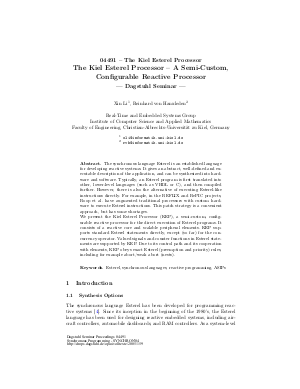The Kiel Esterel Processor - A Semi-Custom, Configurable Reactive Processor
Authors Xin Li, Reinhard von Hanxleden
-
Part of:
Volume:
Dagstuhl Seminar Proceedings, Volume 4491
Part of: Series: Dagstuhl Seminar Proceedings (DagSemProc) - License:
 Creative Commons Attribution 4.0 International license
Creative Commons Attribution 4.0 International license
- Publication Date: 2005-06-30
File

PDF
DagSemProc.04491.6.pdf
- Filesize: 1.19 MB
- 16 pages
Document Identifiers
Subject Classification
Keywords
- Esterel
- synchronous languages
- reactive programming
- ASIPs
Metrics
- Access Statistics
-
Total Accesses (updated on a weekly basis)
0Document
0Metadata
Abstract
The synchronous language Esterel is an established language for developing reactive systems. It gives an abstract, well-defined and executable description of the application, and can be synthesized into hardware and software. Typically, an Esterel program is first translated into other, lower-level languages (such as VHDL or C), and then compiled further. However, there is also the alternative of executing Esterel-like instructions directly. For example, in the REFLIX and RePIC projects, Roop et al.\ have augmented traditional processors with custom hardware to execute Esterel instructions. This patch strategy is a convenient approach, but has some shortages. We present the Kiel Esterel Processor (KEP), a semi-custom, configurable reactive processor for the direct execution of Esterel programs. It consists of a reactive core and scalable peripheral elements. KEP supports standard Esterel statements directly, except (so far) for the concurrency operator. Valued signals and counter functions in Esterel statements are supported by KEP. Due to its control path and its cooperation with elements, KEP obeys exact Esterel (preemption and priority) rules, including for example abort/weak abort (nests).
Cite As Get BibTex
Xin Li and Reinhard von Hanxleden. The Kiel Esterel Processor - A Semi-Custom, Configurable Reactive Processor. In Synchronous Programming - SYNCHRON'04. Dagstuhl Seminar Proceedings, Volume 4491, pp. 1-16, Schloss Dagstuhl – Leibniz-Zentrum für Informatik (2005)
https://doi.org/10.4230/DagSemProc.04491.6
BibTex
@InProceedings{li_et_al:DagSemProc.04491.6,
author = {Li, Xin and von Hanxleden, Reinhard},
title = {{The Kiel Esterel Processor - A Semi-Custom, Configurable Reactive Processor}},
booktitle = {Synchronous Programming - SYNCHRON'04},
pages = {1--16},
series = {Dagstuhl Seminar Proceedings (DagSemProc)},
ISSN = {1862-4405},
year = {2005},
volume = {4491},
editor = {Stephen A. Edwards and Nicolas Halbwachs and Reinhard v. Hanxleden and Thomas Stauner},
publisher = {Schloss Dagstuhl -- Leibniz-Zentrum f{\"u}r Informatik},
address = {Dagstuhl, Germany},
URL = {https://drops.dagstuhl.de/entities/document/10.4230/DagSemProc.04491.6},
URN = {urn:nbn:de:0030-drops-1597},
doi = {10.4230/DagSemProc.04491.6},
annote = {Keywords: Esterel , synchronous languages , reactive programming , ASIPs}
}
